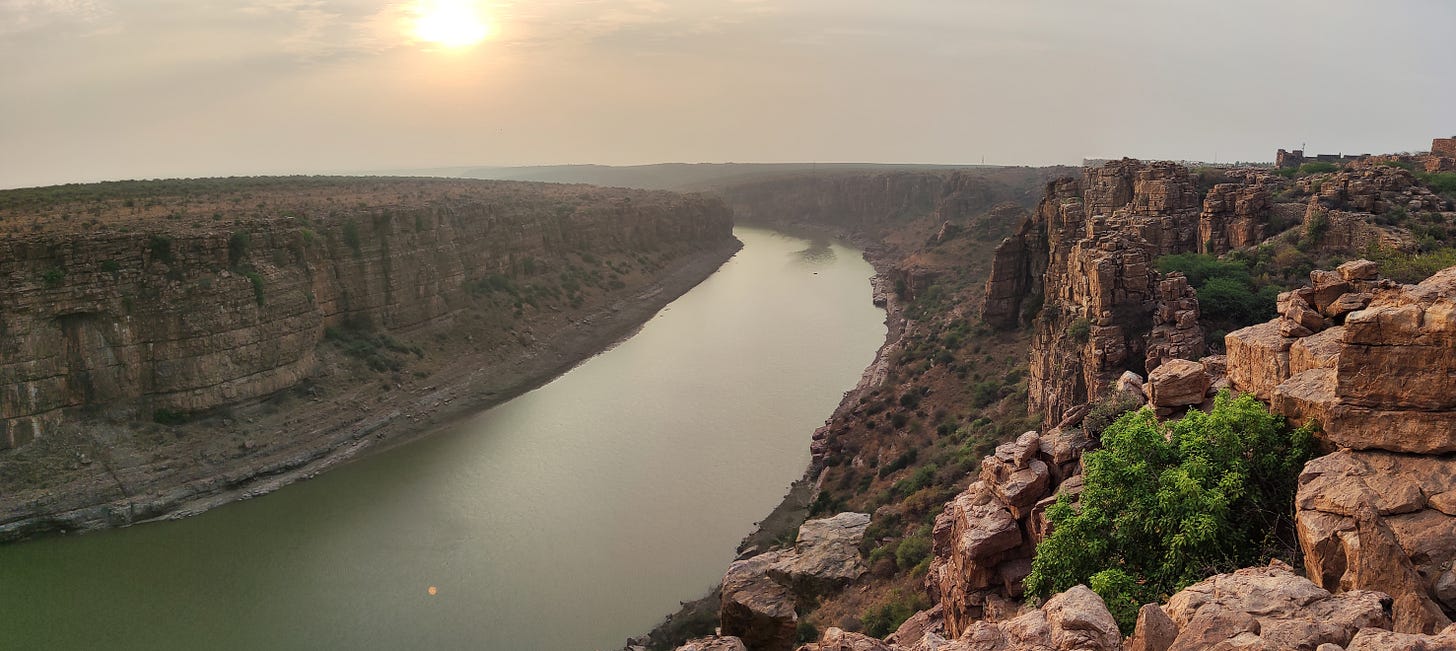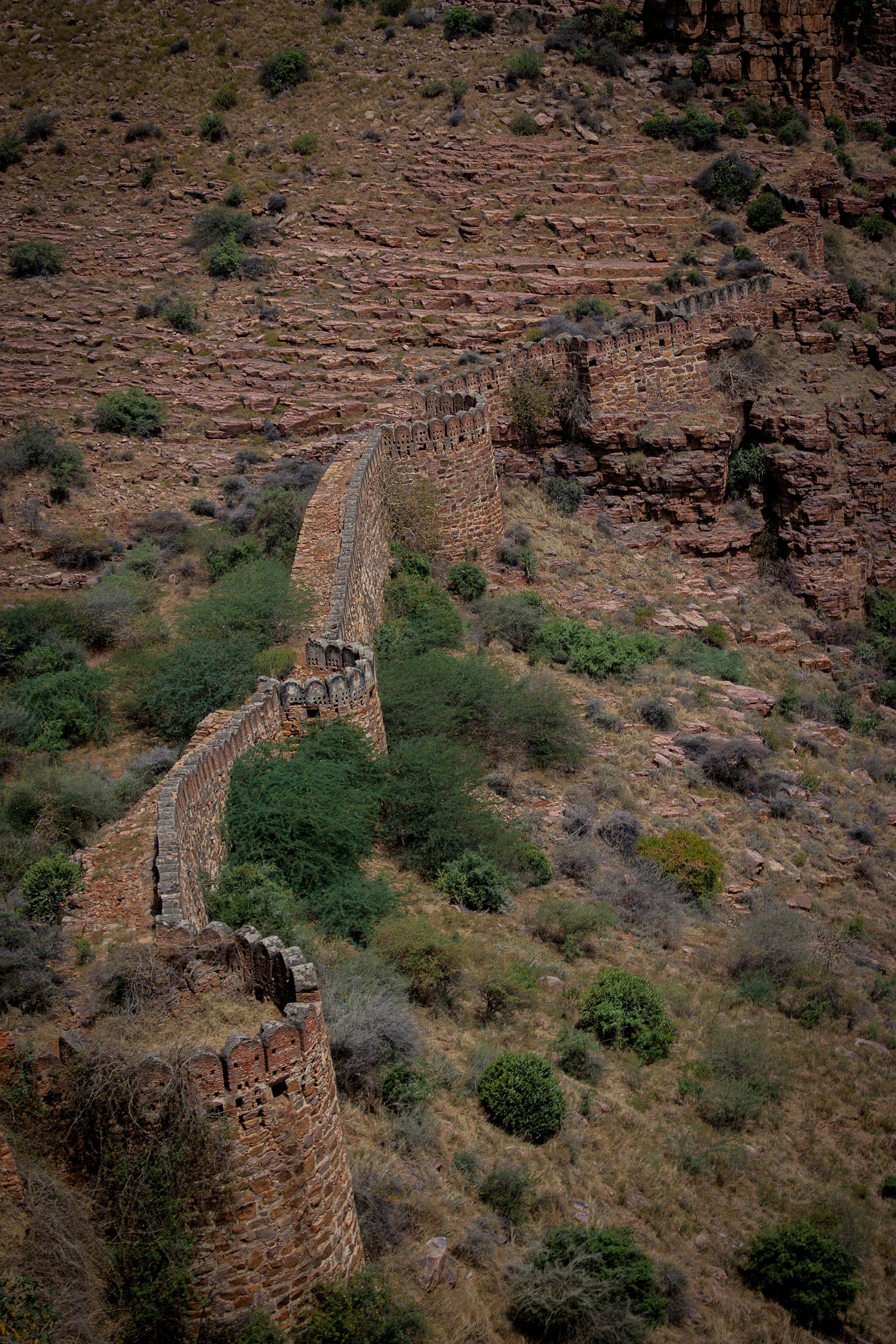Gandikota: The Red Rocks Remember
Where deep canyons and fallen kingdoms whisper of ancient rivers and reigns.

On the drive from Karnataka to Andhra Pradesh, the landscape changes starkly. The sand-coloured boulder-heaps, or inselbergs, with their mosaic of farms and settlements, give way to barren, red-tinged crags, industrial sprawls, and smoke-belching cement kilns. Eighty kilometres, or an hour and a half before Gandikota, if you’re approaching from the south, a bridge near the Sidda Lingeswara Swami Temple skirts a stream hemmed in by two sheer outcrops — this chasm is a doorway to the rugged landscape of the Cuddapah.
As you enter the crescent-shaped depression of the Cuddapah, the landscape whispers of a time when most continents were submerged under shallow seas, and the oxygen had just started accumulating in the atmosphere. The road snakes past small towns and the occasional waterfall, then runs somewhat parallel to the Penna or Pennar river to reach the town of Gandikota.
Nothing prepares you for the scale of the sheer, audacious canyon with its pinkish rocks overlooking the languid greenish river. Thorny shrubs and grassy tussocks push through the crevices, but much of the surface is bare. Today, the calm river belies its passionate, daring past, when it carved its way downwards through thick layers of sediment. As it cut through the alternating bands of shale, siltstone, and quartzite, creating a roughly hewn surface, the river did not erase traces of deeper marine processes that created this sedimentary landscape.
The distinct layers or stratification are the signatures of ancient underwater dunes, the V-shaped, herringbone patterns preserve the back-and-forth motion of prehistoric tides, and the asymmetrical ripples were left behind by waves upon an age-old sandy shore. Further north of Gandikota lie the Belum and Yadiki limestone caves, more relics of a palaeo-marine landscape. After the Cambrian era (538.8 million to 485.4 million years ago), when Earth’s major life forms appeared, limestone formed from the accumulated shells and skeletons of marine creatures like corals and foraminifera. Over time, these remains made of calcium carbonate and other materials get compressed and solidified into limestone, only to be sculpted and carved into a labyrinth of caves and caverns, stalagmites and stalactites, by rainwater.
Yet in the Proterozoic (2500 to 538.8 ± 0.2 million years ago) era, calcium carbonate was mainly precipitated abiotically, with some microbial help. Gandikota’s spectacular sandstone cliff is a result of that process, which later metamorphosed into a light-pinkish quartzite, but still retaining the distinct sedimentary layers.
To stand on this spectacular cliff is to feel the shifting sands from aeons ago, as rock beneath my feet, to watch a once-powerful river that could chisel her way through rock meander by, or to descend into limestones chasms that open up into the belly of the Earth — one realises how precious and precarious our connection is to the planet’s distant past.
Yet even as the rocks speak of oceans long vanished and rivers that carved through time, the silence of Gandikota’s cliffs is deceptive. For atop this Proterozoic stage, history staged its own grand theatre, a drama of ambition, devotion, conquest, and resilience. As the landscape tells the story of the Earth’s deep past, the stones above recount centuries of human enterprise, where bastions rose, banners flew, and the fortunes of dynasties shifted like sediment in a restless tide.

Perched on the rim of this narrow canyon carved by the relentless Penna are the remnants of a fort, a mosque, a temple with a Dakshin-style, brick-layered doorway, a three-storeyed granary, and a jail.
The red quartzite cliffs of the Erramalai Hills, rising 1,670 feet above the coastal plain, pinch the river into a dramatic defile below, creating a natural fortress. Here, sheer escarpments drop into the valley where the Pennar cuts a ribbon through the wild, dry hinterland of Rayalaseema. Access was limited, often perilous; the only road climbed steeply, narrowing at points to a bare seven feet, with a precipice yawning to the right. From this bastion of rock and silence, generations of rulers had held sway, their banners fluttering in the wind above the gorge, while the world below shifted and spun.

Local tradition, preserved in the yellowed pages of the Kaifiyat, speaks of a Chalukyan vassal named Kakaraja who, in the year 1122, first saw promise in this promontory. Whether out of vision or desperation, he and his men fortified the heights, constructing bastions to watch over the valley. By the 13th century, Gandikota had grown from myth into history, emerging as a ‘pattana’, a thriving town under the dominion of Kayastha Ambadeva, a warrior statesman who served the Kakatiyas of Warangal. The inscriptions whisper of conquests and alliances, of sons like Tripurari II and of inevitable defeats, chiefly at the hands of Prataparudra, who rolled down from Warangal with iron in his heart and cavalry at his back.
The rise of Vijayanagara in the 14th century brought new stewards to the rock. Harihara and Bukka, founding emperors of a new southern imperium, saw Gandikota not only as a military outpost but as a symbol of stability on the northern frontier. It was folded into the Udayagiri rajya and overseen by a revolving cast of governors, Pemmasani Nayaks, Nandyala chiefs, and others whose loyalty was tested as often as their swordsmanship. Over time, the fort became both a temple of administration and a beacon of culture, its halls echoing with courtly Telugu verse and the rustle of granaries in trade.
Yet the shadow of the empire is always longer than its sunlit heights. The cataclysm at Rakshasi Tangadi, also known as the Battle of Talikota, in 1565, shattered Vijayanagara’s military lines, and though Tirumala and his Aravidu dynasty tried to reassert control from Penugonda, the provinces grew fractious. Gandikota, once a bastion, now a bargaining chip, slipped from one hand to another. By the turn of the 17th century, Timma Nayar, a fierce and respected local raja, ruled it in a fragile alliance with a Reddi noble, whose lineage traced back to ancient kings but whose future now depended on shifting loyalties and fateful wagers.
It was into this volatile world that Mir Jumla rode.
The Qutb Shahi general, a man of sharp intellect and sharper ambition, was not a Deccani noble by birth, but a merchant from Iran who had bartered his way into command through a mixture of daring campaigns and courtly intrigues. By 1649, having already carved a reputation across the Carnatic, he turned his gaze toward the citadel that had defied so many. The Sultans of Bijapur and Golconda had long coveted Gandikota, and several had laid siege to it. Yet none had succeeded; the cliffs held firm, and the defenders proved wily and bold. Mir Jumla would not make the same mistake.
With an army both vast and nimble, he approached the fort from the only path it allowed, steep, treacherous, and hemmed in by jungle and cliff. Tavernier, the French jeweller turned chronicler, would later write of the horror of the terrain and the precision with which Mir Jumla executed his ascent. The defenders, under Timma Nayar and his Reddi ally, were formidable. Their guns were few, a pair of iron pieces, one on the gate and another on a projecting bastion, but their sorties were fierce, their resistance unwavering.
Mir Jumla, patient and calculating, knew the value of coin over cannon. He seduced the Raja’s Frank gunners, Europeans in local service, offering four months’ wages above their station. It was a quiet mutiny, purchased in silver and sealed in treachery. With their aid, Mir Jumla mounted artillery atop the cliffs, turning the heights from a defence into a platform of death. The gate was struck, splintered by direct fire; the main gun, once the fort’s pride, was rendered useless. The defenders, their morale cracked and their leadership divided, negotiated surrender under terms of honour. For a place once thought impregnable, the fall was swift and brutal.

Tavernier attributed the success to French gunners, others to Dutch and English defectors, and still others to Jumla’s sheer guile. Another French traveller and chronicler, Jean de Thévenot, offered an account even more audacious, Mir Jumla had coaxed the fort’s governor into a supposed league, then detained him under the pretence of alliance, forcing a quiet capitulation. Whatever the truth, Gandikota was his. It was, as one chronicler declared, the crowning feat of Jumla’s campaigns in Karnataka. The fort, with its mosques and temples, its vaulted granaries and jails, its underground water systems and high granite walls, became the seat of his power.
Gandikota’s narrative did not end with Mir Jumla. Over the centuries, the fort passed through the hands of various rulers. Under the Aravidu dynasty, and later amidst the intrigues of Hyder Ali and the brief ascendancy of Tipu Sultan—who in 1708 revitalized the north wall of the fort—the region continued to be a strategic stronghold. Each era left its indelible mark: from the intricate network of three concentric fortification walls and nearly 40 bastions, to the sacred precincts of temples, mosques, and even a modest “Mini Charminar” echoing the grandeur of later Deccan architecture. Ingenious water systems, including underground cisterns and ancient reservoirs, testified to the enduring spirit and ingenuity of its builders.
Today, Gandikota lies drowsy under the sun, a village with echoes. But the stone remains. So do the scars. And in the curling mists above the Pennar, one may still hear the footfall of Mir Jumla’s troops, the distant thunder of cannon, and the whispered schemes of a man who took a mountain not by force alone, but by persuasion, patience, and the silver coin of strategy.
This post was a collaborative piece by Devayani Khare (Geosophy) and Chinmay Kulkarni (Itineraries of ielephantheaded). If you enjoyed it, please share it.







This place looks spectacular! I have never heard of it before, and I will definitely need to pay a visit in the future.
The article is amazing. I love the power and calm of a river. Flows between states constantly. A metaphor for life. Thank you.
https://brianmpointer.substack.com/p/confluence?r=3gsnhb